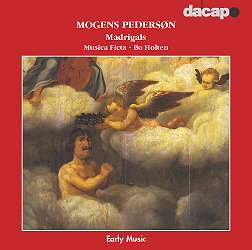The Danish Mogens Pedersøn was sent as
a youth to study in Venice. A few years later, in 1605, he was
back - studying this time with Gabrieli, then a magnet for ambitious
young musicians, and staying for four years. Heinrich Schütz
was there as well. To complete his education, though maybe not
his training, Pederson was then sent to England whose Queen, married
to James I, was Anne of Denmark. With a secure European grounding
Pedersøn rose steadily through the Court hierarchy to the
position of Deputy Master of the Royal Chapel. Doubtless greater
things were in store but for his premature death at the age of
thirty-eight in 1623. Pedersøn had the good fortune to
be active at a propitious time. Under Christian IV, a true Renaissance
prince, arts flourished and a kind of transfer system, familiar
from contemporary sport, held sway. Star composers were loaned
or transferred. Dowland was the most famous of the early visitors
from 1598-1606. Schütz, Pedersønís old student contemporary
in Venice, was the most famous from much later in the Kingís reign,
by which time Pedersøn was long dead.
Pedersøn is the earliest known example
of a Danish composer whose works and biography have survived substantially
intact. Itís not unreasonable to see in his work the profound
dual influence of his Venetian training and also his exposure
to Dowland, both putatively in London and unquestionably at the
Royal Court, as defining features. The Italianate antecedents
are unavoidable, indeed constant, and so too is the Dowland touch.
In a madrigal such as Tíamo mia vita the influence of the
consort settings in the Englishmanís Second Booke of Songs (1600),
published when he was at the Danish Court, seems to me irrefutable.
But Pedersøn was an accomplished musician with ambitions
of his own. The madrigals recorded here were printed as Libro
primo (1608) and were his Op. 1. The second book alas seems
never to have followed; if it ever did itís now lost. The Madrigals
are twenty-one in number, Pedersøn proving himself an adept
and responsive setter of their crux between self-conscious wit
and the melancholy that informs it. The melancholy, so pan-European
in its attraction, and so pervasive a conceit, was often used
as an expressive tool, a formal and well calibrated pose. Pedersøn
plays it for all itís worth in these settings.
Ecco la primavera has some daring harmonic
clashes and in Se nel partir Pedersøn exploits the
verbal disparities through the use of yearning and aggressively
set stanzas. There are moments in the setting of Son vivo e
non son vivo when the female voices sound a little uncomfortable
in the highest positions but there is a splendidly conceived descant.
How avidly Pedersøn exploits the wide open vowel sounds
that the unnamed poet so craftily sprinkles throughout the text.
I greatly admired the voicesí seamless layering in the questioning
setting of Come esser può with its cadential impulses,
its relaxation into a slower, more contemplative section and the
exploitation of the emotional/intellectual states the setting
so adeptly points. Pedersøn is not above some naturalistic
laughter setting. Síio rido et scherzo is a case in point.
However itís the laughter that hides Renaissance tears, adroitly
conceived and equally executed by Musica Ficta under Bo Holten.
It is very much a matter of taste but I found the tempo extremes
of Non voglio più sevire somewhat exaggerated but
they catch the floridity and declamatory Lascia, semplice,
Lascia with fiery pleasure. He nods towards Monteverdiís Il
primo libro de madrigali, which was published in 1587 more
than once in this set but never so explicitly as in Madonní,
Amor ed io. This is a superior setting and, as with the majority
here, less than three minutes in length. But thereís breadth here,
and delicate refinement to end. Et ella allíhor spiegò
shows these facets of his art in the round and is a fine place
to end.
The acoustic of the Torpen Kapel, Humlebæk
is excellent. Nothing muddies, nothing is too distractingly glacial,
and the voices have room to breathe. Holten directs his excellent
forces Ė seven singers Ė with fluidity and acumen. They seem to
relish the wordplay and the drama implicit in these settings as
well as the potential for elasticities of textual meaning and
musical theatre. The booklet is helpful, full of biographical
niceties and this is a most enjoyable disc all round.
Jonathan Woolf

